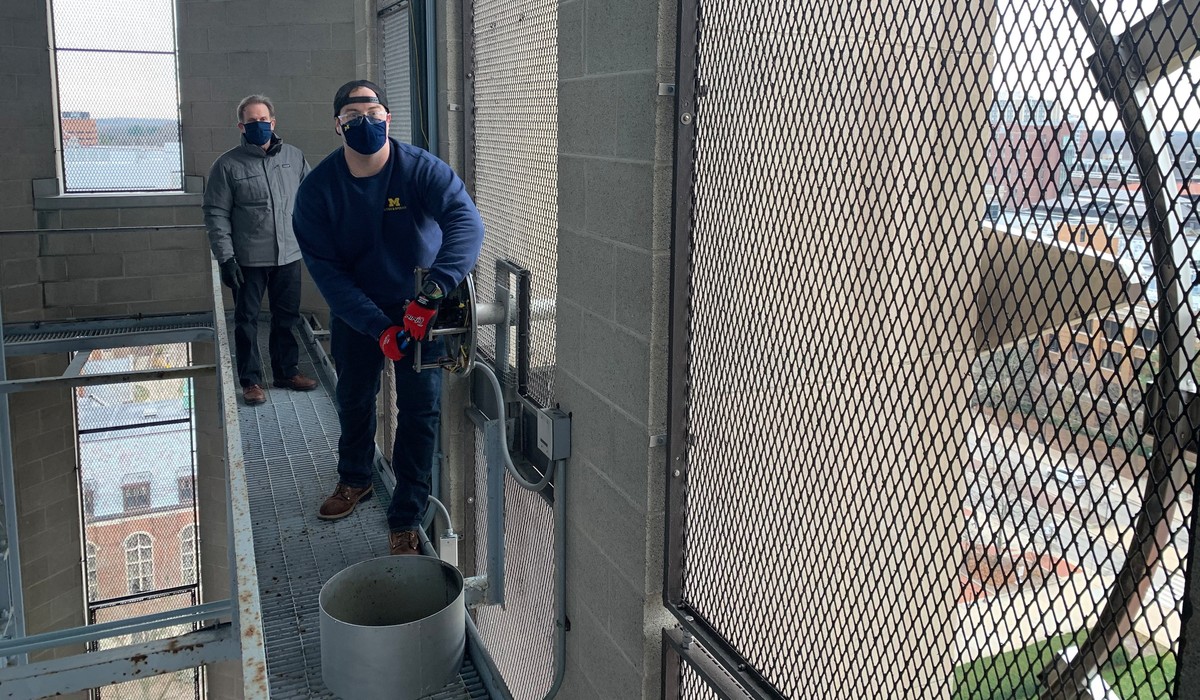While the majority of U-M faculty and staff have been working remotely during this pandemic, the Facilities & Operations (F&O) team has been keeping the Ann Arbor campus running. (F&O handles only major construction and renovation projects on the UM-Dearborn and UM-Flint campuses.) Hank Baier, who is responsible for facilities management at U-M, recently shared some of the challenges his numerous F&O departments have successfully handled during this unprecedented time.
Everyone associated with U-M should be as proud as I am of how the F&O staff rose to the occasion during this pandemic to keep approximately 37 million square feet of space on the Ann Arbor campus operational. Our staff’s contributions have never ceased. As the pandemic has evolved, F&O continues to find creative solutions for executing the work needed all over campus. A few accomplishments particularly stand out.
Innovation
The F&O staff serves the hospitals in many ways, including maintenance and construction. But in April 2020, as the hospitals ramped up to serve an influx of COVID-19 patients, our teams converted patient rooms into special negative pressure rooms to control the respiratory virus. These rooms prevent airborne diseases from escaping and infecting other people. A machine pulls air into the room. Then it filters the air before moving it outside.
This was fast-paced, creative work. Facing a national shortage of high-efficiency particulate air (HEPA) filters, staff converted on-hand HEPA equipment into local ventilation systems. Sheet metal workers fabricated custom window coverings for exhaust ventilation, and the maintenance staff tested the pressure regularly to maintain appropriate infection control.
Collaboration
When clear plastic partitions were needed to separate bus drivers from the passenger compartment, four F&O departments came together to design, manufacture, and install them on 47 buses in just over a week. F&O also went on to share the technology with other transit providers at a time when partitions were not commercially available.
To prepare for the fall semester, the logistics, transportation, and parking department partnered with researchers from the College of Engineering to study the potential for virus transmission on buses using aerosol generators and sophisticated modeling. Faculty and students gained knowledge by contributing to a real-world need. Our F&O staff gained data that informed a complete redesign of bus routes and the onboard experience (including face coverings, duration, distancing, and ventilation) to help keep our drivers and passengers safe. U-M’s School of Public Health faculty also contributed to the assessment.
Dedication
Our custodians performed specialized disinfection of spaces when positive cases of COVID-19 were identified. They also increased disinfection and deep cleaning of spaces throughout campus. Even our grounds staff significantly changed their work by disinfecting outdoor surfaces like railings and crosswalk buttons.
From the beginning, our Environment, Health & Safety (EHS) experts — including six staff with graduate degrees from U-M’s School of Public Health — advised the University on requirements from the Centers for Disease Control and Prevention and the state. They also provided training and helped create a safe environment for faculty, students, staff, patients, and visitors. By fall, EHS was deeply involved with COVID-19 case management and contact tracing for students, often working around the clock to help contain outbreaks.
Keeping University facilities and infrastructure operating safely is all about the dedicated people in our Michigan family working together to support the University’s mission. To read more about U-M’s F&O staff rising to the challenge of COVID-19, visit stories.fo.umich.edu.
Put simply, we make blue go.
Henry Baier, MS’86, is associate vice president for facilities and operations at U-M. As chair of the University’s Finance and Capital Projects Committee, he also oversees more than $1 billion of construction and renovation projects in planning and design on all three U-M campuses.





